Furthering Spanish Fluency
We like to think of fluency as the ability to communicate comfortably, although the more formal definition has to do with proficiency in the skill areas of speaking, listening, reading and writing. Our series called "Furthering Fluency" includes advice and perspectives about achieving fluency.
Furthering Fluency Series:
The Essential Elements to Successful Language Learning
This is probably one of the most important articles we've done. After working with many students and observing the learning experiences of people we know, we have tried to boil all that down to what it really takes to successfully learn a language. It's not about how good you are with languages or your age; these are not really limitations. And, we are not talking about techniques or memory methods, of which there are many. Those things are important but we are focusing on the fundamental underpinnings that you must have to be successful. We identify six things that we believe are essential to successful language learning. Learning a language is acquiring a skill and the key elements we list apply for the most part to learning other skills as well, be it learning to play the guitar or how to ski.
If you want to learn a language and become fluent, the following six elements are essential to success:
-
Motivation. Do you really want to learn Spanish? If so, it's important to make that a commitment and find time in your schedule.
Read more: Motivation is Key to Successful Learning
- Learning how the language works. If you are learning Spanish as an adult, you will of course want to know about pronunciation. And sooner or later you will need to learn more than just vocabulary and a few phrases. To construct your own sentences, you'll need to learn something about how the language works, its rules and structure. This means that grammar will need to be a part of your learning program mix. Learn about the language, then apply it.
-
Practice. If you want to speak and converse in Spanish, you need to learn by doing. As you learn about how the language works, you need to use what you've learned. Speak as much as you can. Use your Spanish in as many situations as possible, through speaking, reading, writing, and listening. Creating your own immersion is very important and for most of us that does not mean moving to a Spanish-speaking country. What it does mean is building your own learning program for self-immersion to supplement your classes (for ideas, see Immerse Yourself in Spanish the Easy Way). Keep it fun and do stuff that you enjoy. Duolingo for 10 minutes a day? Podcasts? Listen to music or watch video content in Spanish? Maybe YouTube after a few beers (slow down the audio if you wish). Read Spanish content? Browse around in Amazon with the language set on Spanish. Whatever works for you.
-
Fun. Learning Spanish needs to be fun for you. If it's not, it'll be hard to stay motivated and practice as you should. Choose a learning program that you enjoy.
-
A Good Teacher. We thought long and hard about whether to include a teacher as an essential element as it seemed self-serving. But in thinking about the many people who we know who learned another language, all had teachers except for some rare instances that included immersion in a country where the locals speak the language, combined with native speakers in the family. For the rest of us, a good teacher is an essential element.
A teacher pulls all the other elements together, plus learning techniques and strategies, to make it all happen in a way that is motivational, effective and fun. You may want to learn Spanish, but knowing where to start and how to go about it is another matter. A good teacher will guide you, create an environment for good learning, answer your questions and help you over stumbling blocks. Having a regularly scheduled class helps you stay organized.
-
Student Responsibility. Success in language learning relies on both the teacher and student. Think of it as a partnership. A teacher can inspire, guide and provide learning content in an encouraging environment, but that won't be enough if the student does not take an active role in her or his learning. Students should be active participants, ask questions and come to class prepared.
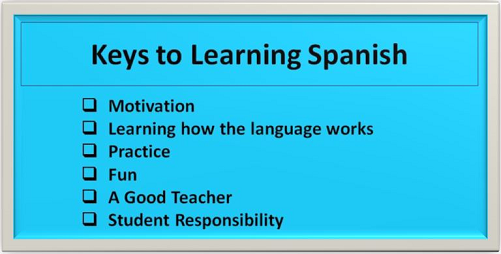
Want to know more? Here are a handful of other articles on this page and our Tips page that expand on these elements:
Motivation is Key to Successful Learning
Don’t Be Afraid to Make Mistakes
Repetition is the Mother of Learning
Is Grammar Really Best Avoided?
Get the Most You Can Out of Your Class
Taking a class with a skilled teacher is the best way to learn Spanish. However, learning a language isn't easy, it takes effort. We've included a number of articles on our website about how you can supplement what you learn in class with activities you can do outside of class. This article is about what can you do during the class to get the most out of it. Here are a few tips.
Listen carefully during class. Make sure you pay attention not just to the Spanish language teaching, but also to suggestions the teacher makes for learning strategies and techniques. It's not just the "what," it's also the "how" that's important to learning.
Let the teacher be your guide. You should be an active participant, focused on learning. The teacher will see what you need and identify the best pathway. That knowledge is part of what you're paying for.
Ask questions during class. Have a doubt? Don't pass up the opportunity to get it addressed in the moment. If you're in a group class, others will also benefit from hearing your question and the answer.
Participate. Whether it's through activities, questions, or conversation.
Appreciate your mistakes and their corrections. Everyone makes mistakes when learning a new language, it's part of the process. A good teacher will often correct a mistake when you make it. Don't let this bother you, it will help you get things right as you learn. Repeating mistakes can glue them in your brain as habits, and you don't want that.
Take notes during the class on important points, including the teacher's answers to your questions. Your notes will help you remember these things. So as to not let note taking distract you during the class, keep it within bounds. You may also find it useful to write down some notes immediately after the class.
Come to class prepared. OK, this is not a "during class" tip, but it sets you up for success during the class. If you have assigned homework, do it. If you have a class once a week and don't do anything related to learning Spanish between classes, it will be very hard to advance each week. Class time is valuable, so come ready to go. Spending a small amount of time studying on several different days is preferable to waiting until shortly before class. Don't skip a reading assignment before class because the teacher will cover the same material in class. You will benefit from the repetition, learning in two different modes (reading and listening), and getting two distinct presentations of the material.
We hope these suggestions help you make the most of your classroom learning.
Our previous article included recommendations for how you can make the most of your classroom learning. But what you do outside of class also  has a lot to do with how well and how fast you progress. Think of it as supplementing your classes by creating your own personal immersion experience without traveling to a Spanish-speaking country. We consider your "immersion" to be any time you focus your attention on the Spanish language, and there are a lot of ways to do so.
has a lot to do with how well and how fast you progress. Think of it as supplementing your classes by creating your own personal immersion experience without traveling to a Spanish-speaking country. We consider your "immersion" to be any time you focus your attention on the Spanish language, and there are a lot of ways to do so.
Any homework you do is important and counts, but we're talking about a variety of other things that fit for you and are fun. If you're tight on time, try to mesh your Spanish activities in with things you already do. For example, listen to a Spanish podcast while cutting the grass or preparing a meal. If you enjoy watching Netflix, why not try a movie with English dialogue and Spanish subtitles. And then there are little things like putting up sticky notes around the house with words on them you want to learn (see our article Learning with Sticky Notes). You'll learn them essentially without study time, just by seeing them frequently.
Take a look at our article Immerse Yourself in Spanish the Easy Way for more approaches. The more you can immerse yourself, the faster you will learn.
What do students frequently ask us about learning Spanish?
We've written quite a few articles about Spanish and the learning process. Listed below are five challenges or questions we hear frequently from students and have written about, along with links to the articles. We hope you'll find them instructive.
I want to speak without making so many mistakes.
Don’t Be Afraid to Make Mistakes
No Hay Otra Manera
I want to be able to speak Spanish without thinking first about every word I say.
Speak Spanish Without Thinking About Every Word
I picked up some Spanish during my travels and now I keep making the same mistakes.
Don’t Habitualize Errors
Can I learn Spanish without studying grammar?
Is Grammar Really Best Avoided?
What are some fun ways to practice Spanish outside of class?
Have Fun Learning Spanish with Movies
Make Reading Part of Your Learning Strategy
Learn with Music
Immerse Yourself in Spanish the Easy Way
The Secret Method for Learning Spanish
Human beings are always looking for a better way to do something. Can it be done faster? With less effort? This is a worthy and often successful quest.  However, this desire is often exploited by marketers to offer false hope and promises to customers. Such is sometimes the case for language learning. It can be fun and rewarding to learn a new language, but it does require effort. Yet, there are many offerings online that claim to use a special method that will teach you a language in short order, with minimal effort on your part. Sound too good to be true? Exactly. Let us debunk some of the most common myths surrounding learning a new language.
However, this desire is often exploited by marketers to offer false hope and promises to customers. Such is sometimes the case for language learning. It can be fun and rewarding to learn a new language, but it does require effort. Yet, there are many offerings online that claim to use a special method that will teach you a language in short order, with minimal effort on your part. Sound too good to be true? Exactly. Let us debunk some of the most common myths surrounding learning a new language.
Myth #1. You can learn a new language in days using some special method.
There is no secret method by which you can learn a new language in a short amount of time. There are indeed a number of different learning techniques, all generally well known in the teaching community. Good teachers integrate quite a few into their teaching. However, there is no “quick and dirty” shortcut for learning a new language. The truth is that you’re not going to truly learn a language in 10 minutes, or ten hours, or 10 days, although you can begin speaking it quickly. Schools and universities use similar academic methods, and the best also include considerable conversation practice.
Myth #2. The best way for adults to learn a new language is to replicate the way they learned to speak as children.
People learn differently at different ages. Adults can learn a language more rapidly by learning some of the rules for how it works. This doesn’t work for young children. Children learn by absorbing what they hear and remember things very well. They begin speaking at a rudimentary level and improve over a period of years. As they get older, they too are taught things like grammar, sentence structure, and writing in school. Adults already know at least one language and are able to understand rules and concepts. So, they can use that to their advantage in learning another language. (see our article, The Adult Advantage in Language Learning)
Myth #3. The best way for adults to learn a new language is without grammar.
Marketers love this one. The pitch is that grammar is boring and traditional approaches force you to endlessly conjugate verbs and the like, whereas their special method teaches you without grammar. In general, adults can learn a new language more effectively via instruction that includes some grammar (how the language works). We have tried going light on the grammar but found that our students wanted to know the rules! Without them, they felt that they were simply wandering around in the language, whereas they could get where they wanted to go more quickly with a map. Such is the case for adults. Courses that claim to be grammar-free often do teach grammar but avoid the G-word like the plague. We think it’s great to disguise grammar, mix it with other content and keep things fun, but it’s just not true that grammar-free is the way to go.
So what's the answer? There are a lot of good ways to learn a language. We'll be following up with another article that boils successful learning down to its key ingredients. For now, you can find plenty of relevant advice on our web pages, Furthering Spanish Fluency and Tips for Learning Spanish. If you take a class from a good teacher, you'll be taught in an effective way and you'll also learn about learning strategies.
How Do I Remember What I Learned?
We all need to remember things, whether it's learning Spanish, guitar, a course at school or how all that stuff on your computer works. Your brain has a difficult job. It is exposed to a huge amount of information and has to decide what to keep (remember) and what to throw away. And it can't keep everything. For example, your brain will probably determine that it does not need to remember exactly what you had for breakfast in the morning, but, given the right cues, that it should remember a good deal of what you learned in Spanish class.
How does your brain it decide what to remember? It recognizes things you work with repetitively and flags them as important to remember. Let's say you encounter the new word cabeza in Spanish class. At that moment, your brain mysteriously codes that word and prepares it for  further processing. Human memory is complicated, and John Medina's book Brain Rules provides some helpful insigh
further processing. Human memory is complicated, and John Medina's book Brain Rules provides some helpful insigh
ts. He states, "We know that information is remembered best when it is elaborate, meaningful, and contextual." Your brain might not remember cabeza for the next class if you don't do anything with that word after the class. But what if your teacher showed you a picture of a hideous, bloody head when she taught you that word? Or what if you worked with that word in some exercises or with flashcards before the next class? Chances are, you would remember it.
These are ways to flag that word so that your brain puts it into long-term memory. The first opportunity occurs at the moment of initial exposure, while other opportunities happen later. As you add more meaning and context, cabeza becomes more memorable. The use of real-world examples communicates meaning, whether it's during the class learning experience or by the learner studying after class.
We build repetition into our classes, but to remember new material, you need to also work with it outside of class. This can start with looking at the material to be covered in class, prior to the class. After class, repeat to remember via review, homework exercises, flashcards, reading, and other immersive activities (see our article Repetition is the Mother of Learning as well as our Tips for Learning Spanish. Your short-term memory is busily processing new information during class. However, this initial memory is transient and if not transformed into a more durable form, it will soon disappear. Repetition can convert short-term memory into a longer term form. Multiple repetitions can cement the memory. This is what you need to do as you learn a language.
Contextual Connections Help You Remember
Our brains are good housekeepers. They're always organizing our memories, such as marking some things as important and throwing other things away. So how does your brain decide what's important? How can you tell your brain to remember what you are learning in Spanish class?
 There are a variety of techniques that can help us remember what we learn. We've written in other articles about the importance of practice or repetition. Here, we're going to discuss the use of contextual connections as a way to improve the Spanish we remember. That is, you can remember something better when it is associated with a context that is relevant and meaningful to you. Perhaps what you are learning has a tie to your personal life, is uniquely related to your interests, or strikes you as bizarre. These are things that get your brain's attention and are more likely to be placed in the "important to remember" record. You're more likely to remember new information when it has some kind of link to what you already know. As for the bizarre category, it's partly the opposite; when your brain recognizes the new information as something that doesn't fit with the reality you know or expect. These connections create a memorable uniqueness.
There are a variety of techniques that can help us remember what we learn. We've written in other articles about the importance of practice or repetition. Here, we're going to discuss the use of contextual connections as a way to improve the Spanish we remember. That is, you can remember something better when it is associated with a context that is relevant and meaningful to you. Perhaps what you are learning has a tie to your personal life, is uniquely related to your interests, or strikes you as bizarre. These are things that get your brain's attention and are more likely to be placed in the "important to remember" record. You're more likely to remember new information when it has some kind of link to what you already know. As for the bizarre category, it's partly the opposite; when your brain recognizes the new information as something that doesn't fit with the reality you know or expect. These connections create a memorable uniqueness.
Let's clarify by way of several examples.
-
I was talking to a family member from Chile about a Belgian style beer from the Alchemist Brewery in Stowe. I described it as a "cerveza bélgica" which she kindly informed me that I meant to say "cerveza belga." Yes, Bélgica is the country, not the adjective. Perhaps this was a small thing, but I easily remembered it due to the family and local brewery links.
-
A pet peeve of mine is hearing students incorrectly say "la problema" instead of the correct "el problema". If I were to pour a glass of water over my head in front of the class and say resolutely, "it's el problema," I suspect everyone would easily remember thereafter. Put this one in the bizarre context.
-
In our article Learning in Small Bites Helps You Remember, we recommend making flashcards that include crazy little sketches, since those sketches make the content even more memorable. Yes, linking context across sensory pathways makes the content more memorable
-
Perhaps you remember the news story that hit in 2015 about "pizza rat" dragging a slice of pizza into the New York subway. Do you think this image can help you remember words like rata or subterráneo?

Perhaps just by reading these examples you'll remember some new words!
So how we can put these concepts to work in helping us better remember or Spanish lessons? We already use contextual connections in our classes. We have students talk about their hobbies or families. Students read and then talk in class about articles or news stories on topics that interest them. Outside of class, using flashcards with peculiar sketches is a quick way to learn new words or verb conjugations. And try making a sentence that includes a new word you want to learn. The sentence could be crazy or fitting to your life (Voy a invitar una rata para comer pizza conmigo). Put some word cards in a hat and draw one every so often and make up a new sentence. You can write the word in English on the back of the card in small letters, in case you are still learning the word and don't remember it.
Any time you can make a personally meaningful connection to go along with something you're learning, you'll remember it better.
Simple, Sensible or Sensitive?
It can be hard to learn the three Spanish words sencillo, sensato and sensible. These are useful words to know but their similarity makes them tricky to remember. And, 'sensible' in Spanish does not mean 'sensible' in English.
Perhaps this is a case for utilizing a mnemonic device, a technique that can make something easier to remember. There are different kinds of mnemonic devices. One involves the use an acronym, for example “Roy G. Biv” to remember the colors of the rainbow (red, orange, yellow, green, blue, indigo, violet). In this case, Similarly, we'll use an expression to help us remember sencillo/sensato/sensible.
Here are the three Spanish words in italics, followed by their meanings in English:
-
sencillo means simple.
-
sensato means sensible.
-
sensible means sensitive.
And here's the Spanish expression to remember, followed by the version in English.

It may take a while to fully remember this, but we hope it'll help you remember these three words. Maybe you can think of a better way to remember them. If so, please let us know and we'll share it.
Use Spaced Repetition to Remember
As we learn Spanish, there are a lot of things we need to remember so we can build up our knowledge over time. But who doesn't struggle to remember the key material covered in class? In our article called How Do I Remember What I Learned? we talked about the importance of repetition (also called practice or review) in order to remember something. And how well we remember depends on a number of factors, one of which is how we space out over time our reviews or contact with new material. In this article, we're going to talk about "spaced repetition" (we'll call it "SR" for short). Spaced repetition is a memory technique that involves reviewing and recalling information at optimally timed intervals until the information is remembered at a sufficient level. The idea is to make your memory efforts more efficient and successful. SR works because it leverages the way your brain works to effectively improve long-term memory recall.
Learning a new language is like building a house. You start with a foundation that supports the rest of the structure. Similarly, you begin your language learning with foundational skills. You won't leave them behind, you will continue to use them as you build your knowledge of the language. That means that your classes will have review and re-use of the material built in. That's great but you will still need to review the material and do some homework between classes so you'll sufficiently understand and remember what was covered. When you come to class well prepared, you'll be ready to progress and we'll accomplish more together. That's where SR comes in. In a nutshell, it's multiple, short reviews where the amount of time between each review increases.
More than a century ago, German psychologist Hermann Ebbinghaus conducted research on memory. He found that 1) when we learn something new, it is rapidly lost over time if no effort is made to retain it and 2) retention can be improved by re-visiting the information at timed intervals. He recommended that the initial review occur soon after the first learning, with subsequent reviews occurring at increasing time intervals. Much work has been done since to expand on his findings, with considerable focus on the timing of reviews for transforming temporary memories into more persistent forms.
Take a look at the example Ebbinghaus "forgetting curve" graph, 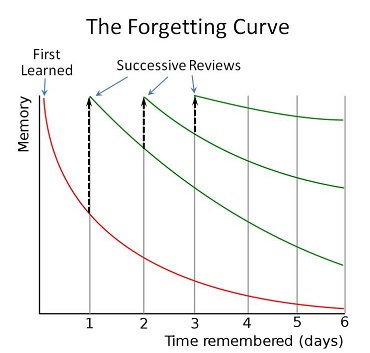 which illustrates his findings. The red curve represents new information we learned in class, and how memory retention drops over time without any review. Each green curve represents a successive review of the new information. Each review brings the remembered information back up to 100%, after which the amount remembered starts to decline again. The amount we remember increases with each repetition, as does the optimum time interval before the next repetition is needed.
which illustrates his findings. The red curve represents new information we learned in class, and how memory retention drops over time without any review. Each green curve represents a successive review of the new information. Each review brings the remembered information back up to 100%, after which the amount remembered starts to decline again. The amount we remember increases with each repetition, as does the optimum time interval before the next repetition is needed.
The concept behind SR is straightforward, and there is general scientific agreement that it works. Of course, everyone wants to know what are the "magic" time intervals are. Unfortunately, there is no simple answer. First, we are all different; one size does not fit all. The timing also depends on the nature of the material you are trying to learn. Scientists agree that SR works but don’t all agree on what the intervals should be. For our purposes, doing reviews is more important than their exact timing. The key is to do your first review relatively soon, before you forget the material. Then do multiple reviews spread out over time.
Some SR methods are quite complex. We want you to give this a shot, and we're going to keep SR simple and practical. We'll go with a commonly used spacing interval, one where the time interval doubles for each review (first review after 1 day, the second after 2 more days, then 4 more days and so on). For example, if your first learning date is May 1, then your review dates would be May 2, 4, 8, 16 and so on. Don't get hung up on the exact intervals; it's OK to deviate a bit if you schedule requires. If you find you don't remember much, reduce the interval. If you know almost all the material, increase the interval. Consider this to be fine-tuning for yourself and the nature of the material you're working with. Some SR apps similarly adjust the timing based on your answers.
Here are some suggestions for how to get started with SR.
Start simple with a modest amount of new material. Review within 24 hours, taking your time to do good job. Each successive review should take less time. Do another review two days later. Add another review four days later. Keep in mind that you won't see results immediately; be patient.
One of the most common SR applications is with flashcards. It's a great way to learn vocabulary, verbs and phrases, and it takes less time than you'd imagine. Read the "why" and "how" in our article Learning in Small Bites Helps You Remember. Another alternative is the Leitner system, which implements SR using a series of boxes to sort flashcards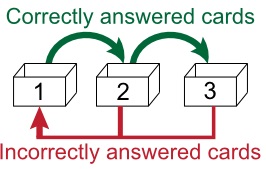 into groups depending on how well you know each one. As shown in the graphic at left, cards start in box #1. When you start your review, cards you answer correctly are moved to the next box, whereas incorrectly answered cards return to the first box. The review interval is daily for box #1, every other day for box #2 and weekly for box #3. As a result, cards that you do not know well are reviewed more often. For more detail, see https://en.wikipedia.org/wiki/Leitner_system. You don't have to use boxes, just put a rubber band around each group of cards with the "box number" on each.
into groups depending on how well you know each one. As shown in the graphic at left, cards start in box #1. When you start your review, cards you answer correctly are moved to the next box, whereas incorrectly answered cards return to the first box. The review interval is daily for box #1, every other day for box #2 and weekly for box #3. As a result, cards that you do not know well are reviewed more often. For more detail, see https://en.wikipedia.org/wiki/Leitner_system. You don't have to use boxes, just put a rubber band around each group of cards with the "box number" on each.
A powerful way to enhance your session is to think up and say a sentence out loud that includes the word or verb form you are reviewing. This puts the material in a meaningful context that helps it stick in your memory.
There are also a number of apps that use the SR system, including Anki, Brainscape, iDoRecall, Memrise (see our article Memrise Wins 2017 Google Play Best App Award and Quizlet.
The more reviews you do, the better the information will persist in your memory. You may find this short YouTube video, Three reasons why retrieval practice boosts learning, to be worth a look.
The SR concept of timed reviews is straight-forward. But perhaps you are saying to yourself, "that's a lot of reviewing and I don't have time for it." You do need a learning program that works for you, and time is always a consideration. While you don't need to remember every single thing from every class, the more you remember, the more successful you will be at learning Spanish. One of the benefits of SR is that it seeks to use your study time efficiently. You'll need to decide where the right trade-off is between time and progress.
SR should be combined with other types of practice that are part of your learning efforts. Review or repetition should include lesson exercises and other non-SR immersive experiences such as using the new material in conversation or writing, reading Spanish language content, using Spanish language audio or video content, and using an app like Duolingo. Learning a new language takes effort but you can make it fun by varying your learning activities and doing those you enjoy and that work for you.
You've probably heard of Spanglish and even some examples of it. It's not a real language, but a way of speaking that mixes words or phrases from both Spanish and English. Some call it "code-switching." Why are such mixes used? For people who speak both languages, the mix can occur when someone can't remember a word in one language and instead inserts that from the other language.  Or perhaps the word from the other language is easier to say or does a better job of capturing a specific meaning. It crops up a lot in Hispanic communities in the US, and in Mexico, Panama and Puerto Rico due to the closeness to the US. Some believe it's cool to mix both languages within a phrase, and it is indeed a common practice in some regions.
Or perhaps the word from the other language is easier to say or does a better job of capturing a specific meaning. It crops up a lot in Hispanic communities in the US, and in Mexico, Panama and Puerto Rico due to the closeness to the US. Some believe it's cool to mix both languages within a phrase, and it is indeed a common practice in some regions.
Since languages evolve over time, Spanglish words considered illegitimate can become accepted. The Royal Spanish Academy (Real Academia Española (RAE)) is charged with safeguarding the correct use of the Spanish language, and that includes the formal addition of new words. The RAE strives to adapt to changes while preserving the characteristic nature of the language and its unity throughout the Hispanic world. As you can imagine, this is a job fraught with controversy. Some people welcome Spanglish additions while others think it degrades "pure" Spanish.
Clínex is an accepted Spanish word meaning a Kleenex or facial tissue; the more traditional Spanish word is pañuelo. The Spanish word for a pickup truck is camioneta. In Mexico or the southwestern US you may also hear troca (similar to the word 'truck'), which has not been accepted by the RAE. Some English words from technology have become accepted in Spanish; email is now accepted as well as the more traditional correo electronico.
There are a host of Spanglish examples online; here are just two:
Necesito ir a la marketa. (Spanglish)
I need to go to the market. (English Translation)
Necesito ir al mercado. (traditional Spanish)
¿Te cambiaste el look? (Spanglish)
Did you change your look? (English Translation)
¿Cambiaste de apariencia? (traditional Spanish)
If you are learning Spanish, it's best to avoid mixing it with another language.
How Much Spanish Do I Need Just to Get By?
Perhaps you're making multiple trips to a Spanish-speaking country, even thinking about moving there. And you're learning Spanish but still can't manage a conversation as well as you'd like. Well, how much Spanish you need to know 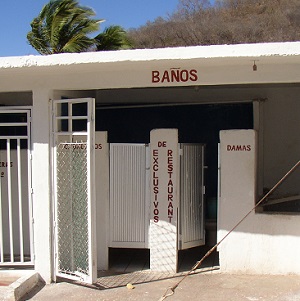 just to successfully deal with basic communications? Fortunately, the answer is "not too much." You'll find that the locals will be thrilled that you are making an effort and will be patient with you. Here's our advice. Learn basic pronunciation. Learn some useful words and phrases, such as the greetings and asking where the bathroom is. Learn basic numbers so you can deal with prices and payments. Take along a phrasebook or your own written list of common phrases. Be courteous and use greetings like hola, buenos dias and of course, por favor and muchas gracias. Keep things simple so you don't get a reply you can't understand. Start out with whatever Spanish you can muster, use it as much as possible and strive to improve as you go. You'll be glad you did!
just to successfully deal with basic communications? Fortunately, the answer is "not too much." You'll find that the locals will be thrilled that you are making an effort and will be patient with you. Here's our advice. Learn basic pronunciation. Learn some useful words and phrases, such as the greetings and asking where the bathroom is. Learn basic numbers so you can deal with prices and payments. Take along a phrasebook or your own written list of common phrases. Be courteous and use greetings like hola, buenos dias and of course, por favor and muchas gracias. Keep things simple so you don't get a reply you can't understand. Start out with whatever Spanish you can muster, use it as much as possible and strive to improve as you go. You'll be glad you did!
Speak Spanish Without Thinking About Every Word
"I want to be able to speak Spanish without having to think about every word." That's what one of our students expressed as her goal when she started taking classes with us. Perhaps you are thinking, "Yes, me too!" This is what many language learners equate with achieving fluency (see also What Does it Mean to be Bilingual or Fluent?).
As we learn a second language as adults, it's natural to have to think as we speak. It's a normal part of the learning process. We are pulling together what
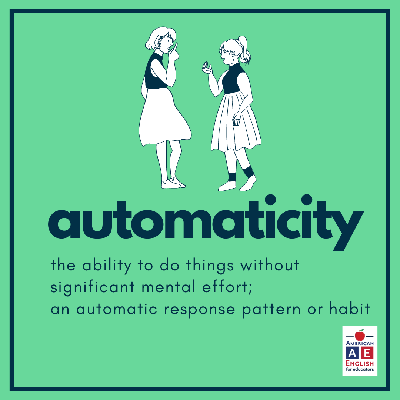
we've recently learned about the language...what vocabulary, which verb tense, proper sentence structure...things that are rattling around in our brains but are not yet second nature. It takes a good deal of practice before we can pull them together without thinking about the details.
Being able to do something automatically or without much conscious thought is called automaticity. It doesn't matter whether you're learning a new language, to play the violin or ride a bike. You need to practice before the activity becomes automatic. Learning a second language is a "walk before you can run" kind of thing; you may find yourself progressing through several stages as you learn to speak. At first, you'll be able to communicate with a assortment of words and some gestures. Then you'll be putting together decent sentences but just in the present tense and with some errors. As you progress further, you'll be using more vocabulary and verb tenses and making fewer errors. And you won't need to think so much about every word.
We sometimes say that you need to repeat something 1,000 times to really learn it; this is sometimes called overlearning. It has to do with repetition beyond initial mastery until you can do it without a thought. Your brain is building new neural connections and you need repetition for this to happen.
LEARNING => PRACTICE => AUTOMATICITY
As you speak more and more, you'll gradually find yourself thinking less about every word before you say it. You'll feel more at ease, and you're on your way to automaticity. So, don't worry if you're not yet speaking without a lot of mental processing. Keep practicing and you'll get there. Maybe you won't even notice as more and more of what you say happens faster and with less and less conscientious thought about details.
How Much Do You Need to Know to Speak Spanish?
Students sometimes ask us how long it takes to learn Spanish. There is no set answer; it depends on the person, their learning program, how much time they devote and the level of proficiency they want to achieve. Most of us must balance the amount of time we devote to learning Spanish with other things in our lives, and that is why most of our SWC classes meet only once a week. At this planned rate, it will generally take several years to get to the point where you can have a basic conversation with a native speaker.
Studies have shown that learning just the 1000 most commonly used words of a language will cover roughly 90% what's in a spoken conversation, and 500 words will get you around 75%. There are some details behind this figure (such 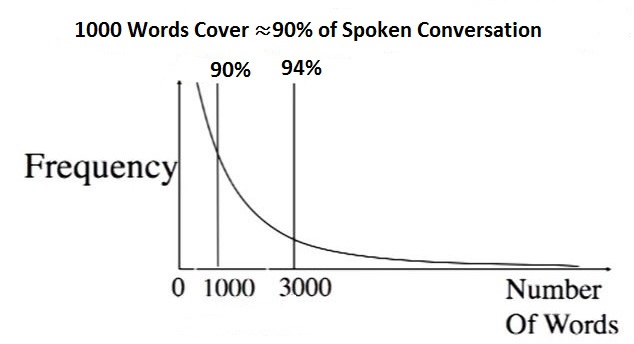 as what counts as a "word"), but the take-home message here is that a modest vocabulary is sufficient for conversation. And if 1000 sounds like a lot to you, it really isn't. Your vocabulary will grow way more quickly than you think as you work with your new language. And, a single word in Spanish often has various forms (verb, nouns, adjectives, adverb) so it's like "Learn One Word, Get 5 or More Free." Not only that, a lot of words in Spanish are the same or nearly the same as in English (see The Spanish You Already Know). Of course, vocabulary by itself won't suffice; you need to learn how to put words together into a phrase. We sometimes get new students who have used computer programs to learn mostly vocabulary but are unable to put a sentence together. The easiest way for an adult to learn to do so is to learn some rules for how Spanish works. Your teacher will help you do that. At SWC, you'll learn pronunciation and vocabulary through usage and practice. You'll learn common phrases and how to construct sentences. End result: you'll speak Spanish.
as what counts as a "word"), but the take-home message here is that a modest vocabulary is sufficient for conversation. And if 1000 sounds like a lot to you, it really isn't. Your vocabulary will grow way more quickly than you think as you work with your new language. And, a single word in Spanish often has various forms (verb, nouns, adjectives, adverb) so it's like "Learn One Word, Get 5 or More Free." Not only that, a lot of words in Spanish are the same or nearly the same as in English (see The Spanish You Already Know). Of course, vocabulary by itself won't suffice; you need to learn how to put words together into a phrase. We sometimes get new students who have used computer programs to learn mostly vocabulary but are unable to put a sentence together. The easiest way for an adult to learn to do so is to learn some rules for how Spanish works. Your teacher will help you do that. At SWC, you'll learn pronunciation and vocabulary through usage and practice. You'll learn common phrases and how to construct sentences. End result: you'll speak Spanish.
Did we mention practice? If you want to learn to speak Spanish, you need a lot of practice speaking, preferably with native speakers. Our classes are small so you'll be speaking and learning new things in every class. And don't worry about making mistakes, just go for it! The more you speak, the better you'll get.
While learning a language isn't easy, Spanish is one of the easiest for English speakers to learn. The reason is that there is so much overlap between the two languages, due largely to the fact that they share roots in Latin and Greek.
Words that share a similar meaning, spelling, and pronunciation in two languages are called "cognates." And, between 30 and 40 percent of English words have a related word in Spanish. If you are an English speaker that is learning Spanish, this is a huge help. Cognates are like a wormhole connecting the English and Spanish languages. Once you recognize the cognate patterns, you'll be traveling through the wormhole to rapidly add a lot of Spanish to your vocabulary. Here are a few examples, with the word in English followed by its equivalent (cognate) in Spanish:
bank = banco car = carro class = clase
curious = curioso(a) education = educación famous = famoso(a)
fruit = fruta office = oficina restaurant = restaurante
There is more to learning a language than just vocabulary, but the thousands of English-Spanish cognates mean that you already know a lot more Spanish than you realize. If you'd like to learn more about Spanish cognates, take a look at spanishcognates.org
English Words Become Spanish Words
There are plenty of words that are the same or nearly the same in Spanish and English, often due to their shared roots in Latin and Greek (see The Spanish You Already Know). But, there are also words from English that have been recently accepted and integrated into the Spanish language. These are known as americanismos.
The Royal Spanish Academy (Real Academia Española (RAE)) has been around for over 300 years are is in charge of maintaining the stability of the Spanish language. The RAE has been the authority of the Spanish language in regards to changes in spelling, new words, and the publication of the most complete and official Spanish dictionary. Languages evolve over time, and the RAE strives to adapt to changes while preserving the characteristic nature of the language and its unity throughout the Hispanic world. Americanismos can also come from other Latin American languages but most are from English. After the usage of an americanismo by Spanish speakers becomes widespread, it may be accepted by the RAE, sometimes with a modified spelling. Words in use but not accepted by the RAE and not considered to be technically correct.
Here a several examples of accepted americanismos. Students of Spanish often find these amusing and prefer to use instead the 'real' Spanish synonyms. We've listed the 'new' accepted Spanish word, followed by its translation in English and then a synonym in Spanish. Tupperware -- really?
| fólder | folder |
carpeta |
| clínex | Kleenex tissue |
pañuelo |
| lonche | lunch |
almuerzo |
| táper | Tupperware container |
recipiente |
The Spanish word for a pickup truck is camioneta. In Mexico or the southwestern US you may also hear troca (similar to the word 'truck'), which has not been accepted by the RAE.
Add What You Learn to What You Say
Learning to speak a new language, like learning to play the violin, takes practice. One of the key challenges is making the jump from learning something new in class to adding that new usage to your everyday conversational abilities. For example it's one 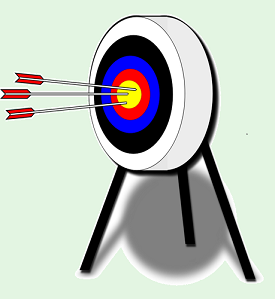 thing to learn a new verb tense, but another to be able to use it correctly in a conversation. If you are already a student of Spanish, you can probably think of a time when you mostly understood a new concept but struggled apply it and add it to your speaking ability.
thing to learn a new verb tense, but another to be able to use it correctly in a conversation. If you are already a student of Spanish, you can probably think of a time when you mostly understood a new concept but struggled apply it and add it to your speaking ability.
So how do you make the jump from learning something new to becoming proficient with its use? We've included a lot of tips in our articles, and here's one we call "Targeted Practice." We have already said many times that practice is important; this is about making that practice more effective. Here's how it works. Take that new topic that you learned and try to use it as much as possible in your speaking and writing. Maybe it's use of the verb haber or the subjunctive mood. Or, perhaps some key words that you can't seem to remember. What we tend to do naturally is avoid our weak areas. But we should do the opposite and deliberately attack them. Use them more. This is a faster way to achieve proficiency in a topic area so your usage will be second nature.
You may want to write up a brief note sheet to refer to during your class or when you are working with your Spanish. And, perhaps put notes up on the wall in your bathroom to provide frequent mini-refreshers (see Learning with Sticky Notes). Then start having a go at targeted practice during conversation. You'll become more comfortable with your topic area and your speaking performance will improve. See also our related article about getting to automaticity (Speak Spanish Without Thinking About Every Word).

Which is harder, speaking Spanish or understanding what a native speaker is saying?
Some say that the receptive skills (listening, reading) are easier than the productive skills (speaking, writing). But is that really true? It depends on your level, your personal strengths and weaknesses, and in the case of listening,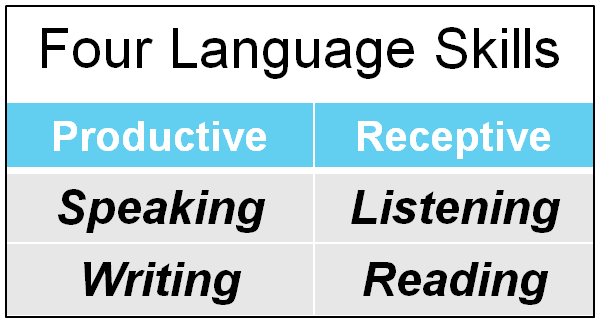 the accent, local words and speed of the speaker. Based on our experience, listening comprehension is usually the most difficult of the four language skills, and it requires a good deal of practice to become proficient.
the accent, local words and speed of the speaker. Based on our experience, listening comprehension is usually the most difficult of the four language skills, and it requires a good deal of practice to become proficient.
When reading, you don’t have to generate the content, you have plenty of time and can consult your translator app, dictionary, verb tables or other references. When trying to understand what someone else is saying, you can’t control the speed and may miss some words, without the ability it play it back. Whether listening or reading, you don't need to know the grammar as much as when you are producing the content by speaking or writing. But, it isn't easy to fully understand what a native speaker is saying.
Beginning students often say that speaking is the hardest, as they are still learning to put together vocabulary and grammar while trying to speak. This is difficult until one has practiced enough. They usually understand some of what others say and are aided here by context and body language, while not being personally responsible for coming up with every word as they are when speaking.
As students progress in their knowledge of Spanish, they are better able to construct their own sentences and speak. They gain confidence and often can communicate quite a bit despite making some mistakes. At this point, students generally say that listening comprehension is the most difficult of the four skills. As beginners, our expectations for listening comprehension tend to be lower and we are more focused on speaking ourselves. Once our speaking ability is OK, we then need to be sure we can get the gist of what others say to us in a conversation.
Let's say that your Spanish is decent and you're visiting Nicaragua. You should be able to go into a bus station, tell them you need a bus to Granada and be understood. Very good. The person is then going to answer you, perhaps explaining a complication about your trip and asking you a question. This is the real test – an unscripted conversation with a native speaker that knows no English. Can you do it? Is understanding the answer harder than what you said? Probably so.
To practice your listening skills outside of class, try listening online to the TV news reporting from a Spanish-speaking country. Watching movies with both Spanish dialogue and subtitles is a good way to practice on your own and build your listening comprehension skills (see also Have Fun Learning Spanish with Movies) before something like the test described above.
Learn One Word, Get 5 or More Free
In another article, we referred to a study that showed about 90% of spoken conversation in Spanish is made up of 1000 words. But what counts as a word? In this case, it's really word forms.
Language consists of two parts: the lexicon (vocabulary) and the grammar (the rules about how you put the words together into sentences). Your lexicon is made up of word forms, or what linguists call lexemes. Let's start with an example in English -- the word "write". If you know that word, you also basically also know its other forms: writing, wrote, writer, and written. It's a "learn 1, get 4 free" kind of thing. It works that way in Spanish too, but you'll often get many more "free" additional word forms than in English. In Spanish, a lexeme often includes a verb and its various forms, several nouns, plus an adjective and adverb. Here's one example: pintar (verb, to paint, and including its various conjugations and tenses); pintura (noun, paint or painting); pintor (noun, painter); pintado (adjective, painted); pintoresco (adjective, picturesque) and then related words such as pintalabios (liptstick or more literally, painted lips). And, other lexemes follow similar patterns for their various forms so you'll pick up them up relatively quickly. So when you learn the root word, you're close to knowing the whole lexeme or all the forms. What a bargain.
Soler and Soltar -- Two S-verbs to Remember
The verbs in the Spanish are a dominant part of the language. As a student of Spanish you'll always be adding new ones to your vocabulary. You'll want to remember the verbs soler and soltar -- they sound similar but have different meanings. And, note that both verbs are "stem-changing verbs" in which the 'o' changes to 'ue' in most present tense conjugations, as is also the case with the common verbs poder, dormir and encontrar.
Soler - to be accustomed to or in the habit of. Example: Ella suele caminar dos millas antes del desayuno. (She's accustomed to walking two miles before breakfast.)
Soltar - to release or let loose. Example: Suéltame la mano. (Let go of my hand.)
If you already know these verbs, great! If not, stick them up on post-it notes at home and use the verbs to remember them.
So much of the power of the Spanish language is in the verbs. When I first started learning Spanish, I bought the popular '501 Spanish Verbs' book…yes that's a scary lot of verbs, but how many do you really need to learn to communicate reasonably well? There is no set number; after all, it's one thing to converse at a beginning level on your first trip to Mexico and quite another to speak like a native. That being said, you can really do a lot with 50, and even better with 100 verbs. And since a verb in Spanish often has similar forms as nouns, adjectives, or adverbs (for example: pagar=to pay, pago=payment, pagable=payable, pagador=payer), learning one makes it easy to pick up the others (See also Learn One Word, Get 5 or More Free).
I now know quite a few verbs but I couldn't tell you how many. I didn't keep count. After all, we don't try to memorize a big list of verbs all at once, checking them off. That's not an effective way to learn and it's not the way we teach Spanish. The best way to learn new words is in a meaningful context, such as what you'll need to know at a restaurant (ordering, names of foods, asking for the check). Reading can also be very helpful.
And, how do we start out learning Spanish as beginners? We learn some greetings like hola and buenos dias and expressions like por favor. After that come more words like chair, woman, cat, tree, tall, black. And then some verbs and their conjugation. And all of a sudden we can make original sentences because we can deal with verbs (The cat is black = El gato es nego. The woman sits in a chair = La mujer se sienta en una silla. A handful of words can combine into a large number of possible sentences, and you're communicating! Mathematically, if you start with 50 words and combine them into groups of four (like a sentence with four words), there are 230,300 possible combinations. The actual number of sensible sentences would be a good deal less, but still a lot. Verbs with a handful of nouns and adjectives make it possible.
If you're a beginner and the table below is new to you, copy it onto a small card that you can carry with you. It has the present tense conjugations for what are known as the -ar, -er and -ir verbs. Pull it out and review it several times a day; it'll just take a minute.
Subject pronoun |
hablar |
comer |
vivir |
yo |
hablo |
como |
vivo |
tú |
hablas |
comes |
vives |
usted/ella/ él |
habla |
come |
vive |
nosotros |
hablamos |
comemos |
vivimos |
Ustedes/ellas/ellos |
hablan |
comen |
viven |
If you know these and you're a SWC student, go to our Recursos web page and under Documents, open 'Present tense conjugations of select irregular verbs' to learn some important verbs with irregular conjugations. Step by step (paso a paso) and your Spanish will be getting better and better. And you won't know how many verbs you know, either.
Motivation is Key to Successful Learning
Imagine how great it would be to travel to Spanish-speaking countries and speak to the locals in their language. So why not learn Spanish? Learning Spanish can be fun and you'll definitely see the benefits when you travel or otherwise use your new language skills. If you want to learn Spanish, you can be successful.
The thing is, like going to the gym or learning to play the guitar, it takes time and effort to be successful. It's not that learning a language is too hard. Finding the time can be a challenge but is generally doable. Often the greatest challenge is committing to your learning goal and sticking with it until it becomes a habit. Why a habit? Because it'll be easier to stay motivated. Just like a morning shower, you do it without thinking about it. Books have been written about this subject but we'll boil things down to a few bottom-line suggestions here. While we've included some specific strategies, this article is really about establishing a learning behavior that works.
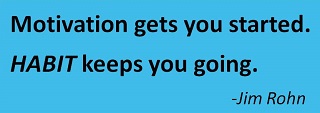 To be successful, establish a routine and stay with it so it becomes a habit. If you're taking a 90-minute class that meets every week, make that class a commitment, a routine that you don't break. For most of us that's manageable, and a class provides social support that helps (not to mention the benefits of learning with a great teacher).
To be successful, establish a routine and stay with it so it becomes a habit. If you're taking a 90-minute class that meets every week, make that class a commitment, a routine that you don't break. For most of us that's manageable, and a class provides social support that helps (not to mention the benefits of learning with a great teacher).
Take advantage of learning opportunities that require very little time. The best way to learn a language is to practice with it a little every day. This will help you create your new habit and is often easier than less frequent, longer times. Here are some suggestions that take very little time. Surround yourself with Spanish with a near-zero time commitment (post-it notes on the bathroom mirror, sentences on the refrigerator). Learn a word every day with the SpanishDict app which will send you the word of the day at the time you choose, such as first thing in the morning (read our article about it). Make yourself some flashcards to learn new vocabulary and run through them at breakfast and during a break later in the day (read about our method). For more ideas, take a look at our tips for learning Spanish; there are lots of good ways to add some Spanish to your relaxation time or non-productive time.
As part of your new routine, plan to review what you learned in your last class and prepare for the next one. Set aside a specific time slot and study in the same place (your Spanish zone). Put it on your calendar. Use your smart phone or computer to set a reminder for your appointment with Spanish and stick to it. You need to turn your Spanish practice into a habit. Start with a modest amount of time, even if it's only 5 minutes today and 10 minutes tomorrow. Before long your brain will respond to the routine and so will you. It'll be more fun and you'll feel a good sense of accomplishment because you'll be making real progress with your Spanish! Have fun and learn!
What is fluency? While there is no one definition, fluency is the ability to communicate proficiently. Our students typically have the most interest in conversation and therefore think of fluency as the ability to carry on a conversation. Our classes integrate all four skill areas but with considerable emphasis on speaking and listening. These two skills need more attention since they are more difficult to acquire. After all, conversation is spontaneous and for the most part you can’t slow it down as you can with reading and writing. So do you need to know all the verb tenses and have a huge vocabulary to be “fluent?” No, and don’t worry about fluency as some mystical level that must be achieved. Language learning is a process of continual improvement. You can start having conversations pretty early in your learning and indeed you should. It’s normal to feel hesitant at first. The words don’t always seem to come, and you make mistakes. However, the key to learning a language (or a musical instrument, or many other things) is practice, practice, practice. So, we encourage our students to speak, speak, speak and accept that there will be errors, and not worry about it. Chances are that whoever you are speaking with has a pretty good idea that this is a normal language learning step and perhaps has also gone through it. Bit by bit, the words will start to flow, the pronunciation will become second nature and you’ll be getting better and better.
Our students come to us because they want to speak Spanish. Yep, real conversation, like talking with a street vendor in Peru. Want to learn to speak Spanish? The recipe for success is simple but not easy.
1. What’s the best way? Get someone who knows both the language and how to teach it and have them teach it to you! And for things to work, it’s got to be fun and you’ve got to be participating and speaking all the time. There’s often lots of laughing in our classes at Spanish in Waterbury Center, and because we keep group size small, you’ll be speaking and learning the language. Private instruction is also a great option. Language learning software programs can be useful support tools, but to learn to speak you need to engage in a conversation with another real person.
2. Is it hard? No, but it’s not easy either. Learning a foreign language takes effort, so you “gotta wanna.” To learn material covered in class means you need to work with the language outside of class. That means some homework and studying. As with sports and many things, the more time you put in, the more you will progress.
3. What is the process? For adults, learning a foreign language is best accomplished through a combination of intellectual learning and practice, keeping in mind that the goal is communication. We have our students start out speaking in their first class, so their speaking skills and comfort level progress along with learning new material.
Learn new material >>> Practice >>> Acquisition
From there, it’s just a matter of adding more to what you’ve already learned. And keep speaking and using your Spanish!
A number of our students come to us with some background in Spanish. Often it’s from traveling in Latin America and what we call learning “en la calle” (in the street). A good thing about this type of experience is that these students are generally comfortable speaking and have gotten over any embarrassment associated with making mistakes. The bad part is that mistakes tend to go 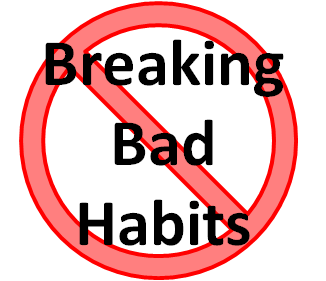 undetected with this type of learning and then become habitualized. How does this happen? When you learn in a foreign country you pick up the language from what you see and hear, of course without exposure to any grammar. You learn to communicate even though you are not always getting it right. For example, if someone learning English said to you, “Black cat see yesterday me” you would probably understand what they were trying to say. But, say that 500 times and you glue it in your brain. That’s a problem because once it’s there, it’s hard to unglue. When you take classes with us, you’ll get “guided practice” -- we ensure that you do not perpetuate mistakes and turn them into bad habits. We use a mix of teaching techniques to keep things engaging, so you’ll develop a proper educational base and get the practice you need. We want you to habitualize Spanish AND glue it in your head…saying things right.
undetected with this type of learning and then become habitualized. How does this happen? When you learn in a foreign country you pick up the language from what you see and hear, of course without exposure to any grammar. You learn to communicate even though you are not always getting it right. For example, if someone learning English said to you, “Black cat see yesterday me” you would probably understand what they were trying to say. But, say that 500 times and you glue it in your brain. That’s a problem because once it’s there, it’s hard to unglue. When you take classes with us, you’ll get “guided practice” -- we ensure that you do not perpetuate mistakes and turn them into bad habits. We use a mix of teaching techniques to keep things engaging, so you’ll develop a proper educational base and get the practice you need. We want you to habitualize Spanish AND glue it in your head…saying things right.
Don’t Be Afraid to Make Mistakes
In our last article, Don’t Habitualize Errors, we explained how travelers who learn Spanish “en la calle” (in the street) run the risk of repeating mistakes until they become habits. While this can be a problem, learning in an immersive environment provides valuable practice. Our students who have learned some Spanish this way often have to correct some bad habits, but on the plus side they are comfortable speaking. Errors or not. Contrast this with the student who has a good academic base but lacks the practice from traveling and is hesitant to speak. To become fluent, you need to speak, speak, speak until the words flow easily just the way they do with your native language. So how do you start, when you're a beginner and still learning? You know you're going to make a bunch of mistakes, right? Many students find this to be embarrassing and are hesitant to take those first speaking steps. However, this is how we all learn a new language. You just have to go for it. And chances are that you'll be speaking with others who have gone through the same thing; they've been there and understand. The good news is that it gets easier the more you do it. So go ahead, speak, practice, get good at it.
Research in brain science, psychology and linguistics all contribute to theories about how we learn languages. But, let’s keep it simple and talk about the ups and downs you may experience as you learn Spanish. First, what do we mean by a “learning curve?” It refers to how fast we learn something, with the word “curve” implying that the rate is very often not constant. And so it is with leaning Spanish. As a student you are likely to experience three stages:
1) Learning the Basics. As you start out, everything is new and your reaction may be, "Gee, there’s a lot to learn." Fortunately, beginning material is straightforward and you should soon transition to "Hey, this is great! I’m learning a lot!" You are getting your building blocks and acquiring your “critical mass” -- that is, enough words and grammar to go on to the next step. You should really feel your progress at this stage.
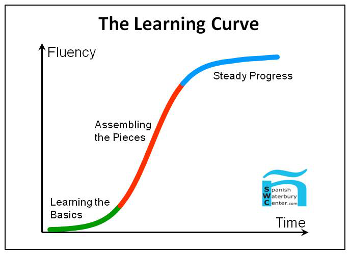 2) Assembling the Pieces. Once you acquire that critical mass and verb-ability, you should feel a “jump” as you begin to really communicate and form your own sentences. This "I can speak now!" stage is an exciting accomplishment that you can be proud of. But, once you turn this bend you may feel like you are not progressing as quickly.
2) Assembling the Pieces. Once you acquire that critical mass and verb-ability, you should feel a “jump” as you begin to really communicate and form your own sentences. This "I can speak now!" stage is an exciting accomplishment that you can be proud of. But, once you turn this bend you may feel like you are not progressing as quickly.
3) Steady Progress. Once you learn the easy stuff, you'll be moving on to more challenging topics. At first your reaction may be something like "Wait a minute, that’s a lot of verb tenses," but that should soon change to the "OK, I’m getting it" feeling. While the challenges are greater, so are the rewards as you are moving to real and quite useful fluency (comfortable, effective communication). This more gradual progress can be harder to notice, but it's happening. Here are some signs. Is your teacher speaking almost all the time in Spanish? And you're understanding almost everything? Do you find yourself thinking less about every word before you say it? Are you relatively at ease speaking? Can you read a book in Spanish with minimal dictionary use? Congratulations! You've made great progress and there's no limit to the level of proficiency you can achieve.
The Common European Framework of Reference for Languages
Have you ever heard someone say they were a B2 level in Spanish? Assuming they weren't talking about their SWC class level, they were likely referring to the levels of proficiency developed as part of the Common European Framework of Reference for Languages (CEFR). The CEFR provides a common framework describing what knowledge and skills language learners need to develop as they learn a language, and it describes six reference levels of proficiency. These reference levels are widely accepted, and students often use them to determine their language learning level. Are you curious about your level? If you would like to get a general idea without spending a lot of time, then just take a look at the CEFR reference levels online or in the following summary table. A quick review of the table will probably give you a good idea of your level.
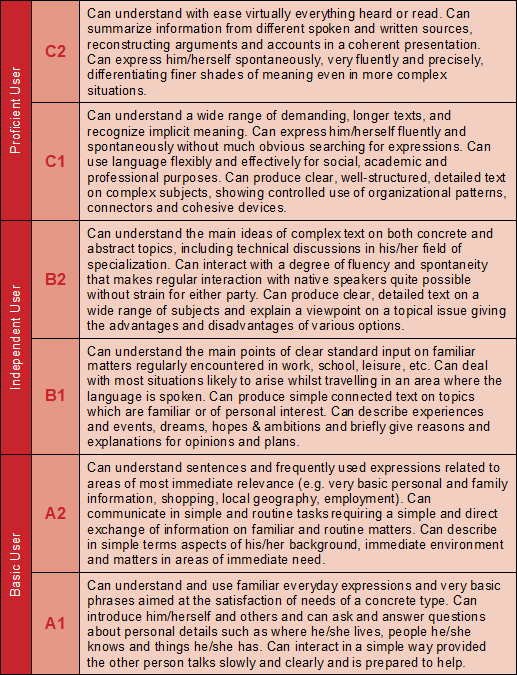
If you would like to dig deeper and assess your level for each of the four skill areas (speaking, listening, reading, writing), take a look at the CEFR self-assessment grid.
Do you think your Spanish is pretty solid? You might enjoy giving one of the various free online tests a try. For example, the test at https://www.languagelevel.com/spanish/index.php includes 15 multiple choice questions and takes about 10 minutes to complete. You'll get the results immediately. Good luck, this is an international scale and it's not easy!
Learning in Small Bites Helps You Remember
Did you ever cram for an exam the night before? Chances are that the material didn’t stick in your brain for the longer term. But, repeated mini-reviews can do so -- and without a big time commitment. For example, spending 10 minutes with flashcards a few times a week can “peg” or glue that new vocabulary in your brain. Think of the Spanish verb pegar, which means to glue, to paste, to stick (adhere) or to put up (poster, picture) and imagine pegging those words in your brain. So, try breaking your study efforts into more frequent, shorter blocks. 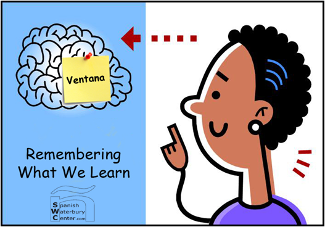
While flashcards may seem old-fashioned and unexciting, they really can help you effectively and rapidly learn new vocabulary or phrases. Digital flashcards are built into a number of today's language learning apps. However, we recommend that you make your own, since the act of writing and preparing each card is in itself an important multi-sensory step toward gluing/pegging the material in your memory. It’s worth the effort (vale la pena).
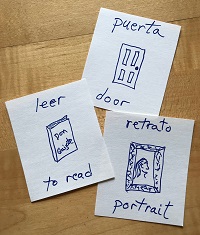 Just get some 3x5 index cards and cut them in half so you’ll have cards 2.5” wide by 3” tall. Write your word in Spanish near the top of the card and then the English translation near the bottom. Add crazy little sketches in the middle if you want; it'll help your brain peg it. Shuffle them if you want. Use the top card as a cover for the one below it. Slide the top card down to reveal the Spanish word on the one below it. When you’re ready to check your answer, reveal the English at the bottom of the card. Each successive card can go to the bottom of the deck for review, or remove the ones you know to reduce the deck down and focus on those you don’t. Chances are that you can go through them and remember most of the words in maybe 20 minutes (let’s keep each deck down to a manageable number of cards, say 20-50). Go through them again the next day. If you're remembering most of the material, spread out the number of days between reviews. You may be surprised at how soon you can remember your new Spanish!
Just get some 3x5 index cards and cut them in half so you’ll have cards 2.5” wide by 3” tall. Write your word in Spanish near the top of the card and then the English translation near the bottom. Add crazy little sketches in the middle if you want; it'll help your brain peg it. Shuffle them if you want. Use the top card as a cover for the one below it. Slide the top card down to reveal the Spanish word on the one below it. When you’re ready to check your answer, reveal the English at the bottom of the card. Each successive card can go to the bottom of the deck for review, or remove the ones you know to reduce the deck down and focus on those you don’t. Chances are that you can go through them and remember most of the words in maybe 20 minutes (let’s keep each deck down to a manageable number of cards, say 20-50). Go through them again the next day. If you're remembering most of the material, spread out the number of days between reviews. You may be surprised at how soon you can remember your new Spanish!
Repetition is the Mother of Learning
If you are learning Spanish, the more you can interact with the language, the better. That's a message that we have stressed before and have included a SWC webpage full of helpful Tips for Learning Spanish.
Repetition is an essential step toward getting your brain to say to itself, "Hey, this seems like something I've heard before; it must be important so I'd better record it in my long term memory." While your brain obviously doesn't have that dialogue with itself, the process does in fact work much like that. And, the more frequent the interaction with Spanish, the better.
We know that our students have many things competing for their time in addition to Spanish.  So how does one find the time for frequent immersion? While learning a language does involve some focused "studying" or learning how the language works, your immersion time can include activities that most of us enjoy more (such as watching a movie with Spanish dialogue or subtitles; listening to Latin pop music in Spanish). And, immersion can be multitasking -- things you can do while you do something else, such as the prior examples while you work out at the gym or at home, listening to podcasts while driving, cooking or cutting the grass, reading some online Spanish content on your lunch break, and so on. Read a book in Spanish. You can even shop on Amazon in Spanish (see our how-to article); don't worry, it's easy to swap back to English if you need to. Or try 10 minutes with the Duolingo app every other night before bed. Give these and other ideas from our website some thought and do what works for you.
So how does one find the time for frequent immersion? While learning a language does involve some focused "studying" or learning how the language works, your immersion time can include activities that most of us enjoy more (such as watching a movie with Spanish dialogue or subtitles; listening to Latin pop music in Spanish). And, immersion can be multitasking -- things you can do while you do something else, such as the prior examples while you work out at the gym or at home, listening to podcasts while driving, cooking or cutting the grass, reading some online Spanish content on your lunch break, and so on. Read a book in Spanish. You can even shop on Amazon in Spanish (see our how-to article); don't worry, it's easy to swap back to English if you need to. Or try 10 minutes with the Duolingo app every other night before bed. Give these and other ideas from our website some thought and do what works for you.
The above immersion activities primarily involve watching, listening and reading, in which you are receiving the communication. Perhaps the greatest challenge is getting enough practice actually speaking Spanish; here are some suggestions:
-
Speak as much Spanish as possible on your trip to a Spanish-speaking country. Don't be shy.
-
Speak in your class. This is a great way to get help with your questions and broaden your abilities.
-
Find a native speaker or friend that you can converse with (either orally or in writing).
-
Sing along to those Latin songs.
-
Read out loud.
-
Find an online language exchange partner. (see our article Online Language Exchange)
Make Reading Part of Your Learning Strategy
 If you are learning Spanish, reading is a big deal. Reading helps you review and remember what you’ve learned in class. Just hitting a topic once won’t glue it in your memory, whether it’s Spanish or how to use a new computer program. Reading also helps you learn new vocabulary as well as proper sentence structure. The order of the parts in a sentence are often different in Spanish than in English, so you want to become familiar with correct Spanish sentences. Learning grammar rules can be helpful, especially at beginning levels, but you should try to immerse yourself in correct usage of Spanish to learn to speak. Practicing listening and speaking are obviously important, but so is reading. Studies have shown that reading is one of the best ways to improve language proficiency. All should be part of your learning through actual use of the Spanish language.
If you are learning Spanish, reading is a big deal. Reading helps you review and remember what you’ve learned in class. Just hitting a topic once won’t glue it in your memory, whether it’s Spanish or how to use a new computer program. Reading also helps you learn new vocabulary as well as proper sentence structure. The order of the parts in a sentence are often different in Spanish than in English, so you want to become familiar with correct Spanish sentences. Learning grammar rules can be helpful, especially at beginning levels, but you should try to immerse yourself in correct usage of Spanish to learn to speak. Practicing listening and speaking are obviously important, but so is reading. Studies have shown that reading is one of the best ways to improve language proficiency. All should be part of your learning through actual use of the Spanish language.
The more Spanish you know, the more reading options you have, but reading material designed for beginners is also available. At times during our class sessions, we'll use short novels that are written specifically for your level. There is also quite a lot of material available online; here are two good sources that include free readings for beginner, intermediate, and advanced levels.
https://cvc.cervantes.es/aula/lecturas/
https://www.learnpracticalspanishonline.com/index.html
Add reading to your learning; you'll definitely get results and chances are you'll enjoy it too.
We've touched on this topic before, but it needs to be said again. The natural tendency for a student learning another language is that she/he feels embarrassed about speaking because of making mistakes. It is important to get over this. To learn to speak, you need to speak. You have to be willing to speak, knowing you will make some mistakes. Everyone, yes everyone, who learns a new language goes through this. You just can't go from "book learning" to perfect speaking without passing through imperfection en route. The good news is that it's no big deal. Others will understand and give you a break. So if you have a chance to speak with someone in Spanish, consider it a valuable opportunity and do it! Aprovechar is the what we're talking about here! This is how you'll learn to speak.
The Adult Advantage in Language Learning
Here at SWC we have students of all ages, from babies to seniors. Yes, children are brain-wired for rapid language learning and have great memories. Their progress at learning Spanish is remarkable. So if we begin learning Spanish years later as adults, have we missed the boat? We sometimes hear people say, “I’m too old to start learning Spanish.” The fact is, anyone can learn a foreign language, regardless of age. If you’re interested and make an effort, you can do it. And, there are several factors that give adult learners advantages over kids.
As they learn their first language, kids first pick up vocabulary. They then need to learn about concepts such as how to put a sentence together and that things change between singular and plural. This ability develops naturally over time, but indeed they are starting from zero. In contrast, adults have an advantageous head start – they already know at least one language and how it works! While Spanish and English of course have their differences, overall they are pretty similar. Nouns, verb conjugation, adverbs and adjectives? Yup. The same alphabet? Nearly. Lots of words that are the same or similar? Thousands. So, adults start out way ahead.
Brain science and experience have shown us that children are definitely primed for language learning; we often say “they learn like sponges.” While this is a big deal, adults on the other hand are better positioned to focus on a topic, apply reasoning, recognize errors, and comprehend concepts and rules of grammar. This is one reason why we do teach adults about grammar. Even though it is sometimes shunned by the “secret methods” you may read about online, the fact is that learning the rules about how a language works is a good fit for the adult mind. Adults and kids learn and think differently. Adults have passed the sponge stage but moved on to be experienced and analytical. That’s not all bad.
We have to give kids the edge on pronunciation. They’re great at distinguishing between similar sounds and learn to speak a new language without any accent. In general, if you learn Spanish as an adult you will speak with an accent. Fortunately this doesn’t usually hinder communication much.
Students sometimes ask us, “How long does it take to become fluent?” This of course depends a great deal on the intensity of your learning schedule, but we are usually talking about a period of years with a non-intense schedule. That may sound like a long time, but think about how long it took you to learn your native language? How old does a child have to be before she/he can speak her/his native language competently? This is not a question that has a simple answer because language acquisition includes a number of stages, but let’s say age 4 or 5. And this is with lots of parental assistance and basically constant immersion. This doesn't mean that kids are slow learners; the fact is they are learning a ton of other things at the same time and as we said, starting from scratch. But, adult learners can learn Spanish faster than this with a reasonable level of study. Kids are great, but we have adult students who are amazing too!
That said, a child who grows up with considerable exposure to and use of two languages will become truly bilingual. That's a really tough level for an adult to achieve later in life.
So the take-home message is this: get your kids started early with Spanish and if you want to learn too, you can do it!
Is Grammar Really Best Avoided?
I remember my first trip to Mexico. I bought a phrasebook that came with an audio cassette tape. I listened to the tape and reviewed the book, but I was basically clueless. I had learned some vocabulary, which was good. While I was able to also say some phrases that I had learned, I had no idea where they came from or anything about how the language worked. I could not construct an original sentence, and forget about understanding what anybody said to me. Still, I developed a strong desire to learn more and began taking classes. In the beginning this meant vocabulary, some greetings and simple grammar like masculine/feminine. But then I learned some verbs and their conjugation and felt like I had finally broken through the barrier. Finally I could make an original sentence! And not just one, but thousands, just by combining my limited repertoire of nouns, adjectives and verbs. If I had not learned those simple grammar constructs, I would have still been trying to learn like a parrot – listen and repeat without understanding how to construct something new. It’s true that grammar can sometimes be less than exciting. But for me, learning how the language works (yes, that’s grammar) is the key to using it. And don't worry... classes at SWC are fun! We blend grammar with using the language because that's what it's all about -- learning to communicate!
Have Fun Learning Spanish with Movies
The best way to learn Spanish is practice the language as much as possible (see Immerse Yourself in Spanish the Easy Way) and make it fun. A lot of people enjoy watching a movie and learning Spanish at the same time. That’s not homework, right? And there are some great movies, whether you want shoot-em-up action or quality drama. Movies are definitely a great way to immerse yourself in genuine dialogue, as well as culture. And, it’s important to hear how native speakers speak, for the pronunciation, the rhythm and the intonation, and use of common expressions and even how sentences are put together. Movies will also help you learn new vocabulary and cement words you already know. You might even pick up some cool lines to use when the right opportunity comes along. Don't worry if you think you can't understand anything....you are in fact getting some words, learning pronunciation, and the rhythm of the speaking. Don’t hesitate to use subtitles. The table below provides a quick summary of the different subtitle options. You will want to start with English subtitles but move to both subtitles and dialogue in Spanish as you improve. You may find it helpful to first watch a movie with subtitles in English and then again with Spanish. Or try watching the movie more than once; you may be surprised at how much more you pick up the second time around. Some people like to watch a movie many times over until they have almost memorized dialogue.
Level |
Dialogue |
Subtitles |
Comments |
1 |
English |
Spanish |
Start here. You’ll see the Spanish in writing and will recognize some words, then more as you build your skills. You'll see a sentence in Spanish and hear what it means in English. |
2 |
Spanish |
English |
This is the next step. The English subtitles will help you recognize what you hear in Spanish. Processing both languages at once is not ideal but you will still learn a lot. |
3 |
Spanish |
Spanish |
It’s good to go 100% Spanish. It’s usually easier to understand the written text than the spoken words. Assuming your reading ability is ok, the subtitles will help you comprehend the dialogue. Seeing and hearing the words together is doubly-good! |
4 |
Spanish |
None |
If you can get the gist of the dialogue without subtitles, you will definitely be focused on listening comprehension. You will find quite a few movies with Spanish dialogue and only English subtitles, in which case you’ll have to try either level 2 or 4. |
While there is no shortage of Spanish language films with subtitles available in English, perhaps less than half of them also have subtitles in Spanish. If you want Spanish subtitles, you'll want to verify they're available when you choose your movies. Netflix now was quite a bit of Spanish language content to pick from. Ask your teacher for suggestions.
Fluency is about stepping beyond the textbook and into the conversational world, where you’ll need two skills. You will need to listen quite a bit until you get good at recognizing what you hear native speakers saying in Spanish. You will also need to create and speak your own sentences, and with practice the words will flow more and more the way they do for your native tongue, as a subconscious reflex. Enjoy building your skills with movies. Also see our articles Learning Spanish with Netflix and Spanish Videos for Beginners.
Learning a Second Language Helps Your Brain
We say it all the time: she's really smart, he's not good with languages, I can't remember anything anymore. Are we just stuck with the brain power we were born with? Are our brains going downhill as we get older? Or can we make ourselves smarter and improve our learning and memory? Fortunately, the answer to the last question is "yes." Science today is revealing more and more about how our brains function, providing us with information on things we can do to help our brains to improve function and learning effectiveness.
We know that we can learn something by practice, whether it's playing the piano or speaking a new language. Scientists talk about neuroplasticity which means that our brains are adaptable and will build up in the areas where we use them. So, the right kind of exercise for your brain can make you smarter. Here are some of the specific ways that learning a second language helps power up your brain:
-
language centers of the brain will grow and improve function
-
memory will improve
-
listening skills will get sharper
-
decision making skills will improve
-
multi-tasking ability will be enhanced
-
your brain will stay healthy
A study from the University of Edinburgh in Scotland, recently published in Annals of Neurology, found that learning a second language has positive effects on the brain, including improved intelligence levels, reading skills and verbal fluency. Student age doesn't matter, nor is it necessary to reach a high level of fluency.
Don't just take our word for it, check out this excellent 5-minute TED-Ed video, The benefits of a bilingual brain by Mia Nacamulli. This animated video is fun and easy to understand. Just click the YouTube play button below.
Learning Another Language: a Brain Fitness Program
When we ask our students why they want to learn Spanish, no one says “to improve cognitive function of my brain.” It’s seldom the primary motivation but definitively one of the benefits. Viorica Marian, an expert in bilingualism and communication science at Northwestern University, recently published a study demonstrating that speaking more than one language exercises your brain and improves its ability to filter information. [Brain and Language; November, 2014]

Marian used functional magnetic resonance imaging (fMRI) to measure brain activity in volunteers who were asked to perform language comprehension tasks. She found that people who spoke two languages (as opposed to one) could more efficiently process information in the face of distractions.
When your brain works with more than one language, it’s like a continual exercise program. Your brain is constantly deciding which language to turn on and which to turn off. This strengthens your inhibitory control, the ability to focus on what matters and ignore what doesn’t. Mentally juggling more than one language strengthens this ability; it’s like a body building program for your brain.
We live in a busy world today, often with many things going on at once, and are bombarded with information. Being able to focus on the task at hand and filter out potential distractions is more important to success than ever. It now appears that the more your brain switches between languages the greater the benefit will be. According to Marian, “It’s never too late to learn another language. The benefits can be seen even after just one semester of studying.”
Learning a second language is a lot like a physical workout program. Both require motivation and practice and are more successful when you enjoy what you're doing. You can have fun learning something new, get more out of your visits to Spanish-speaking countries, and open up new employment opportunities. And, you’ll also reap the cognitive benefits that extend beyond language learning.
On May 27, 2015 National Public Radio aired a story about research on the advantages of hand-written notes over those done on a laptop. That study opens the door to a related broader topic, having to do with learning Spanish and remembering what you learn.
The research project found that taking notes by hand, rather than by laptop, results in better recall of the material because it requires mental processing of the information. To take notes by hand, you need to summarize and record key points. That requires quick comprehension and synthesis, and the result is better recall. The issue with laptop note taking is that it tends to be word for word typing of what is being said.
found that taking notes by hand, rather than by laptop, results in better recall of the material because it requires mental processing of the information. To take notes by hand, you need to summarize and record key points. That requires quick comprehension and synthesis, and the result is better recall. The issue with laptop note taking is that it tends to be word for word typing of what is being said.
In our SWC article Learning in Small Bites Helps You Remember we talk about how the act of writing something down, which involves a brain-eye-hand interaction, actually helps glue the material in your brain. You remember it better.
SWC teaching methods make the most of how we learn and remember. In the classroom, this means that a mix of verbal and visual content, writing things on the board, and making the class interactive and fun are key to good learning. Pictures and quirky things grab your brain’s attention. Participation does too. At SWC, you’ll be thinking, learning and speaking Spanish, with a smile on your face. We use technology as a great support tool for language learning, but our focus is always on the use of engaging methods that help our students effectively learn Spanish.
What Does it Mean to be Bilingual or Fluent?
When someone says they are fluent or bilingual in another language, what do they mean? Well, not always the same thing; the meanings are a matter of some debate. While the terms are used most often in relation to speaking, they can also refer to the skill areas of reading, writing and listening comprehension.
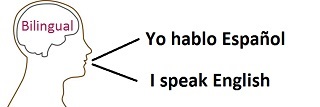 A widely accepted definition of bilingual is the ability to speak two languages equally well, easily and naturally. Many consider bilingual to mean the ability to speak both languages like a native speaker. This level of proficiency can result from growing up in a home where two languages are spoken. It is also possible to learn a second language later in life, as may happen when someone immigrates to a new country where a new language is spoken. However, bilingual is also sometimes used in a much looser context, to mean just “some” ability to communicate in two languages.
A widely accepted definition of bilingual is the ability to speak two languages equally well, easily and naturally. Many consider bilingual to mean the ability to speak both languages like a native speaker. This level of proficiency can result from growing up in a home where two languages are spoken. It is also possible to learn a second language later in life, as may happen when someone immigrates to a new country where a new language is spoken. However, bilingual is also sometimes used in a much looser context, to mean just “some” ability to communicate in two languages.
Fluent is more universally understood as meaning a high skill level with a language. A person who is fluent can speak a language easily and accurately. The term is often used to describe a non-native speaker who speaks a language very well. Some people associate fluency with being able to speak without hesitation, without translating in your head as you speak.
As things stand today, these words are not clearly defined and can reflect various levels of language proficiency. There are however quite a few detailed assessment scales that clearly define levels of proficiency. One straightforward example is that used by the U.S. Department of State with its personnel, shown in the following table.
U.S. Department of State - Levels of Language Proficiency |
||
Proficiency Code |
Speaking Definitions |
Reading Definitions |
0 - No Practical Proficiency |
No practical speaking proficiency. |
No practical reading proficiency. |
1 - Elementary Proficiency |
Able to satisfy routine travel needs and minimum courtesy requirements |
Able to read some personal and place names, street signs, office and shop designations, numbers and isolated words and phrases |
2 - Limited Working Proficiency |
Able to satisfy routine social demands and limited work requirements |
Able to read simple prose, in a form equivalent to typescript or printing, on subjects within a familiar context |
3 - Minimum Professional Proficiency |
Able to speak the language with sufficient structural accuracy and vocabulary to participate effectively in most formal and informal conversations on practical, social, and professional topics |
Able to read standard newspaper items addressed to the general reader, routine correspondence, reports, and technical materials in the individual's special field. |
4 - Full Professional Proficiency |
Able to use the language fluently and accurately on all levels pertinent to professional needs. |
Able to read all styles and forms of the language pertinent to professional needs. |
5 - Native or Bilingual Proficiency |
Equivalent to that of an educated native speaker. |
Equivalent to that of an educated native. |

